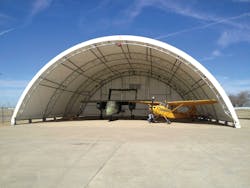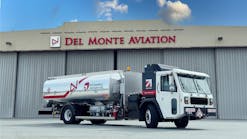Flying is an expensive sport and business, and making sure aircrafts are safe from nasty weather and secure for passengers requires a dependable and affordable structure. When you can’t be in the clouds, keep your wings covered and consider the worthwhile investment of a fabric structure.
Fabric structures help dozens of industries protect their materials and operations for an affordable price and minimal construction demands. These buildings provide versatile, durable and spacious solutions to business challenges and for folks in the aviation industry, fabric structures can be implemented for any number of purposes, like covering for luggage transportation, holding flight passengers and repairing aircrafts. Private aircraft owners who don’t fly often may need to store an aircraft for an extended amount of time, but regardless of particular aviation needs, aviators count on innovative engineering in every aspect of their business. When choosing buildings for aircrafts and airfields, these structures provide industry-leading innovation.
With materials that can be designed to fit any customized building needs, fabric structures are suitable for any aviation business or private owner and come at a fraction of the cost and time spent on traditional buildings. Fabric buildings come with a clear advantage for the aviation industry.
Versatility
There are many applications for fabric structures in the aviation business. Individual aircraft owners, fixed-base operators, regional airports and international airports can meet aviation industry building needs with a fabric structure. Uses range from luggage inspection shelters, vehicle inspection shelters and passenger holding spaces, to sizeable aircraft hangars or terminals. Fabric structures are adaptable to any environment and can be used across every climate. Furthermore, these structures serve all sized aircrafts or any airport need, making them versatile structures for an industry with many requirements.
Fabric Covers
Because many aircrafts are concentrated along the coast where conditions or seasonal changes are unfavorable for proper airplane upkeep, aviation always requires close monitoring of the environment. This makes fabric structures an ideal solution to airplane storage challenges. Protecting aircrafts from the elements in most regions will be something important to consider. Their qualities of durability and weather safety provide fabric buildings with a long, low-maintenance life, and owners are able to maintain a constantly controlled environment.
Fabric covers are tested to withstand heavy snow loads and high winds. The fabric material protects the contained aircrafts from extreme heat and simultaneously allows natural light into the building, which can drastically reduce the electrical costs of artificial lighting. Because the interior of a fabric structure does not allow in oppressive summer heat, the temperature remains comfortable no matter the climate.
The low costs of fabric buildings challenge the high costs of traditional buildings. Not only do traditional building materials cost more, but repairs each season can make the costs of owning buildings extremely high.
These fabric-covered buildings are made of domestic materials and can be customized to meet any need. Choosing a fabric structure for aviation needs provides owners with a much more sustainable option than repairing and rebuilding broken-down hangars.
Aesthetically speaking, fabric buildings have a contemporary and clean look that is impressive from the outside, but the inside is where the magic happens.
Spacious Interior
The frame of these structures is made of triple-galvanized steel and the weight of the building is distributed effectively with a truss-arch design, creating a clearspan interior. There are no support beams in the way of the floor or ceiling space. This means that with a fabric building, there is more cubic feet coverage all around. A spacious overhead and no inconvenient interior support columns allow facilities to effectively store any size aircraft in a clean environment. The wide open interior of a fabric structure ensures maximum useable space for mechanical and maintenance crews. Furthermore, this interior makes it remarkably easier to maneuver any size aircraft without damaging the structure or other equipment. Endwalls and sidewalls are customizable for easy access in and out of the hangar.
Sturdy Foundation Options
Fabric structures come with a variety of foundational options that range from temporary to permanent, but are all strong enough to withstand the weight of an aircraft. The buildings’ temporary option makes it simple to expand or move an operation. Fabric structures are easily and quickly erected and their materials are more cost-effective than standard buildings. With various foundation options, some fabric building companies adapt to any desired hangar locations, which means there is no need to pour a foundation and customers can often times avoid costly permits.
Constructing these structures takes a fraction of the time that traditional buildings take to build. Conventional buildings can take months to construct. In contrast, fabric structures can take only a number of days from start to completion, and this is largely due to the limited foundation requirements.
Some companies offer the option for a Helical Anchoring System. The system utilizes a number of large, metal anchors that drill directly into the ground. When using this foundation, there is absolutely no need for poured concrete. One of the best parts of opting for this system is that it allows the structure to be built in places that it normally wouldn’t be able to. It nearly eliminates excavation and allows for the structure to be built much quicker.
All of these characteristics make a fabric structure an easy, spacious and cost-effective choice for any aviation building need. Customers enjoy the ease with which these structures are built and their versatility and strength while in use. The building process is simple from beginning to end.
Ready For Take Off
ClearSpan has decades of experience in designing and constructing high-quality, low-cost fabric buildings. Across limitless industries, their customers have experienced first-hand the benefits of fabric structures. One of these customers is John Tevelonis, an aviator in Pennsylvania.
Tevelonis found that the need for repairs comes with every season when using a traditional building. After years of replacing and repairing his travel trailer cover, he wanted to choose something versatile and durable that could be depended on for years in the future. Faced with the typical challenges of an old, conventional building, Tevelonis decided to replace his old steel hangar with something new, so he put the word out that he was looking for something more innovative. A friend of Tevelonis who worked for the Pennsylvania DOT steered him toward ClearSpan.
“I had a friend with the Pennsylvania Department of Transportation who told me the department had tried multiple companies and structures for salt and equipment storage, with ClearSpan being the clear number one option,” said Tevelonis.
With his friend’s endorsement, Tevelonis purchased a 56 feet wide by 60 feet long ClearSpan Round HD Building, to house multiple small planes, including his Pterodactyl Ultralight.
Tevelonis couldn’t be more pleased with his building solution. He said, “The fabric building has worked out fantastic. The structure is so incredibly strong and massive and was a pleasure to construct.”
ClearSpan’s Truss Arch Specialists work with customers to customize their buildings to fit specific business challenges and make the building process as seamless as possible. Customer service was a major selling point for Tevelonis. He was impressed with the attentiveness and punctuality of all the ClearSpan staff. He said, “The service was fantastic, ClearSpan’s team couldn’t have been more professional and cheerful when dealing with all my requests for changes.”
This fabric building turned out to be the best choice for Tevelonis. He continued, “The materials are all first-class quality. We were actually given extra material due to possible alternate configurations.” Another facet of the building Tevelonis loves is the translucence of the fabric cover. He reported the building lights up even with dim outdoor light, and it looks fantastic when lit up at night.
Tevelonis has one piece of advice for people thinking about making a similar purchase. He said, “Don’t waste your money on an inferior building. We could not be more pleased with our fabric building, and our friends and family call the structure a ‘work of art’. ” With a clean and contemporary look, fabric buildings add an aesthetic that sets businesses or individual aviators apart from others toting traditional, permanent airplane hangars.
Whether covering a single personal aircraft or trying to develop logistics of an airport, dependable and trusted structures are vital to operating efficiently. Shopping smart for a building solution can help save enormous overhead costs and make life a lot easier.
Making a wiser, more economical choice is easy when you see how many ways ClearSpan Fabric Structures can keep your business covered. With savings around every corner, fabric buildings are a worthwhile decision when challenged with keeping aircrafts protected from nature. Browse through designs and read about these structures at ClearSpan.com.
Contributed by Amanda Williams






